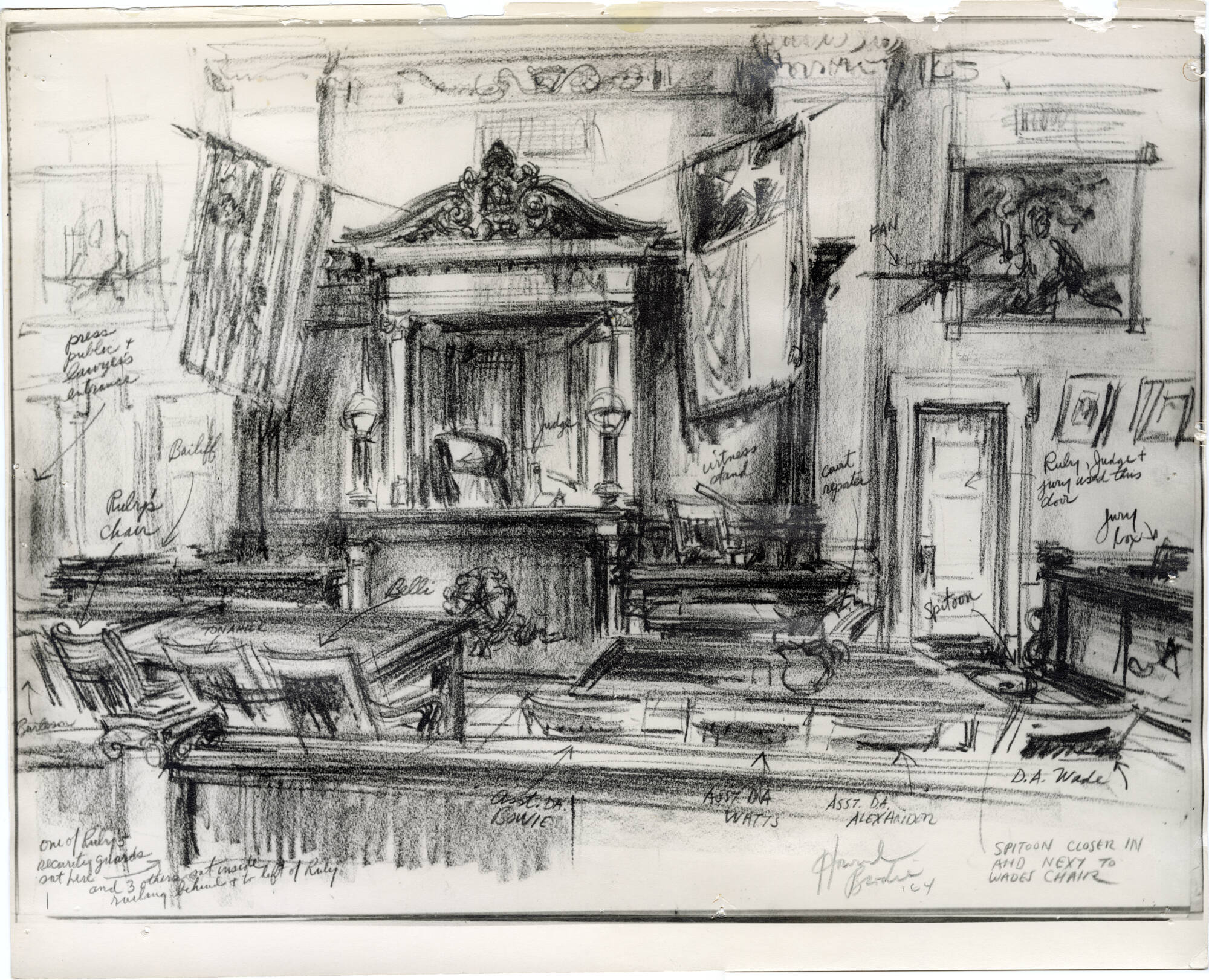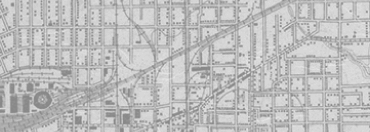


Back
Photograph of courtroom sketch of Jack Ruby trial courtroom with notes
Photograph of courtroom pencil sketch on paper by CBS News courtroom artist Howard Brodie. The sketch shows the courtroom during the Jack Ruby trial in February or March of 1964. The courtroom is empty, with the judge's bench in the background. A large American flag and a large Texas flag stick out of the wooden scrollwork behind the judge's bench. Two tables designated for the attorneys, the witness stand, and the jury box are all labeled in the image, as are many of the other details of the courtroom. The artist has labeled every chair with the name of the individual who sat there as well as where different individuals stood, the different doors used, and even the spittoons on the tables and the ceiling fan overhead. The artist's signature "Howard Brodie '64" is located along the bottom edge under the sketch. Brodie made the original pencil sketches for CBS News during the trial of Jack Ruby after the judge barred cameras from the courtroom. Brodie then gave Joe Tonahill this photograph of a courtroom sketch as part of a collection of more than 40 in 1964.
Photograph of courtroom sketch of Jack Ruby trial courtroom with notes
February 1964 - March 1964
Paper, Adhesive tape
16 1/16 × 19 15/16 in. (40.8 × 50.6 cm)
Tonahill Family Partners Collection/The Sixth Floor Museum at Dealey Plaza
2014.034.0001
Howard Brodie (1915-2010) was a sports artist for the San Francisco Chronicle when he enlisted in the U.S. Army with America's entry into World War II. He ultimately became one of the best-known sketch artists of the war, frequently published in the weekly U.S. military magazine, Yank, which ran from June 1942 to December 1945. After the war, Brodie spent the next thirty-five years as a courtroom artist, attending several notable trials including the Chicago Seven, Charles Manson and, of course, the Jack Ruby trial in 1964. For the Ruby trial, Brodie worked as a CBS-TV artist correspondent. Mr. Brodie recorded an oral history with the Museum in 2006. -- Stephen Fagin, Curator

Photograph of courtroom sketch of Jack Ruby trial courtroom with notes
Photograph of courtroom pencil sketch on paper by CBS News courtroom artist Howard Brodie. The sketch shows the courtroom during the Jack Ruby trial in February or March of 1964. The courtroom is empty, with the judge's bench in the background. A large American flag and a large Texas flag stick out of the wooden scrollwork behind the judge's bench. Two tables designated for the attorneys, the witness stand, and the jury box are all labeled in the image, as are many of the other details of the courtroom. The artist has labeled every chair with the name of the individual who sat there as well as where different individuals stood, the different doors used, and even the spittoons on the tables and the ceiling fan overhead. The artist's signature "Howard Brodie '64" is located along the bottom edge under the sketch. Brodie made the original pencil sketches for CBS News during the trial of Jack Ruby after the judge barred cameras from the courtroom. Brodie then gave Joe Tonahill this photograph of a courtroom sketch as part of a collection of more than 40 in 1964.
Photograph of courtroom sketch of Jack Ruby trial courtroom with notes
February 1964 - March 1964
Jack Ruby trial
Sketches
Photographs
Press
Trials
Jury
Artist
Artwork
Brodie, Howard
Tonahill, Joe H.
Belli, Melvin
Ruby, Jack
Wade, Henry M.
CBS News
Dallas
Paper, Adhesive tape
16 1/16 × 19 15/16 in. (40.8 × 50.6 cm)
Tonahill Family Partners Collection/The Sixth Floor Museum at Dealey Plaza
2014.034.0001
Howard Brodie (1915-2010) was a sports artist for the San Francisco Chronicle when he enlisted in the U.S. Army with America's entry into World War II. He ultimately became one of the best-known sketch artists of the war, frequently published in the weekly U.S. military magazine, Yank, which ran from June 1942 to December 1945. After the war, Brodie spent the next thirty-five years as a courtroom artist, attending several notable trials including the Chicago Seven, Charles Manson and, of course, the Jack Ruby trial in 1964. For the Ruby trial, Brodie worked as a CBS-TV artist correspondent. Mr. Brodie recorded an oral history with the Museum in 2006. -- Stephen Fagin, Curator









